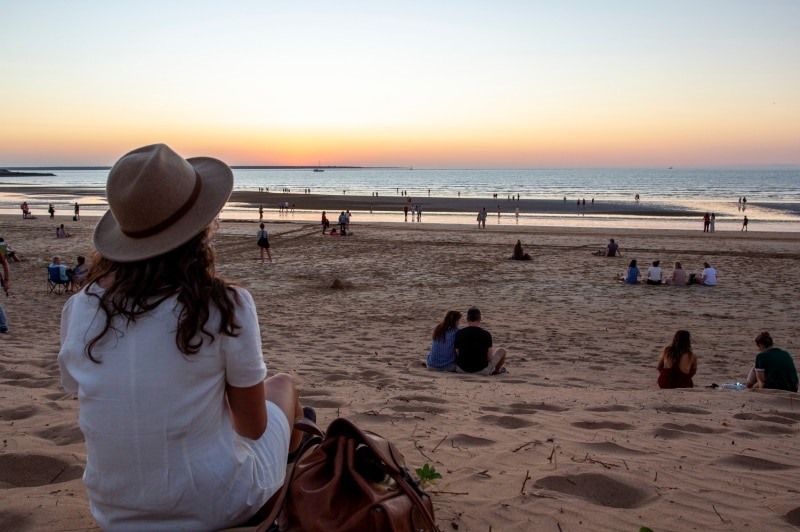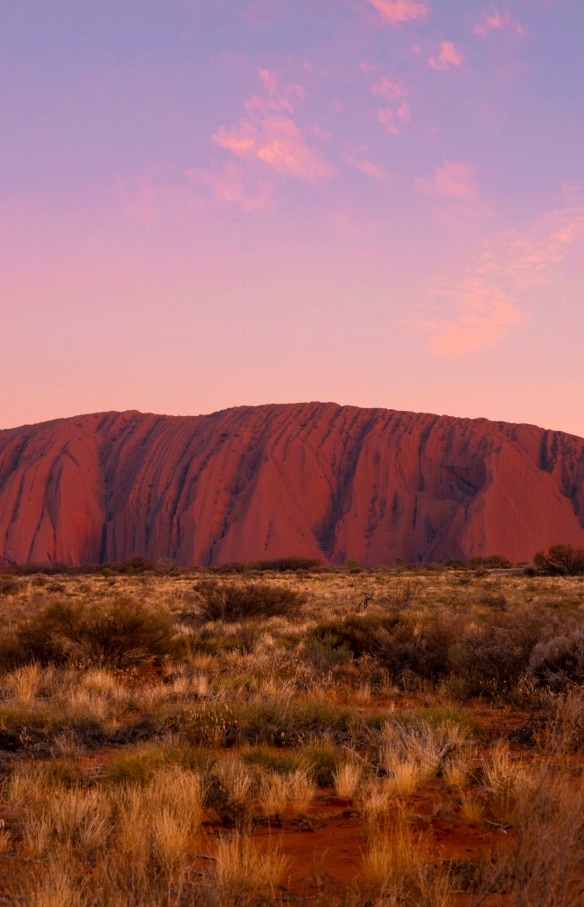
Walls of China, Mungo National Park, New South Wales © Destination NSW
A guide to Australia’s World Heritage sites
From ancient Aboriginal sites to rainforest wonders, here’s how to visit Australia’s greatest natural and cultural treasures.
Budj Bim Cultural Landscape
Budj Bim Cultural Landscape
The Gunditjmara people of south-west Victoria built stone houses and complex aquaculture systems to farm fish and eels at Budj Bim more than 6,600 years ago. It's one of the world’s oldest human settlement sites, demonstrating the dynamic relationship that Aboriginal and Torres Strait Islander people have with their ancestral lands. Join a Gunditjmara guide to experience this rich landscape to the fullest, then stop into the Tae Rak Aquaculture Centre to sample local bush foods.
K’gari
K’gari
The world’s largest sand island and home to the local Butchulla peoples, K’gari is both culturally and ecologically significant. There’s an impressive diversity of natural landscapes, from shifting sand dunes to tropical rainforests. Float in a bright blue lake, walk beneath a towering forest and 4WD on the beach – you might even spot a dingo (never approach or feed them). The six-to-eight-day K'gari Great Walk will take you to all the best places, but you don’t have to do it all – stay at eco-friendly Kingfisher Bay Resort and explore a different walk each day.
Gondwana Rainforests of Australia
Gondwana Rainforests of Australia
This collection of verdant rainforests is among the only places on the planet that remain relatively unchanged since the dinosaurs roamed. It’s the largest swathe of sub-tropical rainforest in the world and contains almost all the world’s Antarctic beech cool rainforest. Immerse yourself in the greenery at O’Reilly’s Rainforest Retreat in Lamington National Park, a two-hour drive south of Brisbane. The mountain-top retreat offers a range of guided walks and activities, from Segway safaris to glow worm tours.
Great Barrier Reef
Great Barrier Reef
The Great Barrier Reef is the world’s largest living structure and one of the most complex natural ecosystems on the planet. The numbers are mind-blowing; 3,000 coral reefs, 600 islands, 300 coral cays and 150 inshore mangrove islands. Together, these magnificent landscapes are home to 1,625 kinds of fish, 600 types of coral and more than 30 species of whales and dolphins. You can access the reef from popular spots such as Cairns or Airlie Beach, or, you can become a citizen scientist and join reef researchers in the field on a five-day expedition with Earthwatch on Magnetic Island.
Kakadu National Park
Kakadu National Park
As the homeland of the Bininj/Mungguy people for more than 65,000 years, Kakadu is one of the best places in Australia to experience the world’s oldest living culture. The national park is jointly managed by the area’s Traditional Aboriginal Owners, and there are countless brilliant ways to engage with their rich cultures. See rock art at Nourlangie and Ubirr, learn more about Kakadu’s heritage by exploring with an Aboriginal guide and join a Guluyambi Cultural Cruise to learn about local culture and bush survival skills.
Lord Howe Island
Lord Howe Island
Home to the world’s southernmost coral reef and the world’s tallest sea stack (coastal rock formation), this rainforest-covered volcanic island is truly otherworldly. The island is home to just 350 people, but 500 species of fish and some of the world’s rarest birds also reside here. With only 400 visitors permitted at any time and no cars, visits here are filled with nature adventures – think hiking, cycling and snorkelling. You can opt to stay at Capella Lodge to enjoy this island paradise in true luxury, with pools fringed by rainforest, exceptional dining and a pampering day spa.
Purnululu National Park
Purnululu National Park
Also known as the Bungle Bungles, this spectacular range is more than 350 million years old and is home to unique black and orange rock beehive domes. The world’s best-kept geological secret, the area was known only to local Aboriginal people and a few farmers until the 1980s. You can wander through the marvellous natural formations with local Gija and Karjaganujaru Traditional Owners with Kingfisher Tours, or marvel at the domes from above during a helicopter safari.
Sydney Opera House
Sydney Opera House
Opened in 1973, the Sydney Opera House is a masterpiece of modern architecture and one of the world’s most recognisable buildings. It’s also the youngest cultural site ever to be included on the World Heritage list. Built with the future in mind, the architect Jorn Utzon incorporated clever sustainable design elements such as a cooling system using seawater from the harbour. If you’ve ever dreamt of singing on stage in the world's most famous concert hall, join an early morning backstage tour, or marvel at the building’s unique features during an architectural experience. Those with limited mobility can also join one of the daily mobility access tours.
Tasmanian Wilderness
Tasmanian Wilderness
You’ll never have to worry about crowds at this World Heritage site. Occupying the southwest corner of the island state of Tasmania, the Tasmanian Wilderness is one of the world’s last truly wild places. Covering almost 20 per cent of the state, the fight to save this expanse of temperate rainforest in the 1980s gave birth to the green movement in Australia. There are plenty of ways to explore, like cruising deep into the most remote stretches of Bathurst Harbour and rafting your way down Franklin River.
Uluru
Uluru
Sacred to the local Anangu people, Uluru is one of Australia’s most famous natural landmarks, and the magnitude of its raw beauty and energy has to be seen to be believed. Uluru-Kata Tjuta National Park is managed with a mix of modern science and Tjukurpa (traditional knowledge), and the best way to experience this region is alongside Traditional Custodians. Join a SEIT Uluru Tour to hear Creation stories, see ancient rock art and learn about Uluru’s continuing significance. When the sun goes down, marvel at a local Anangu story told through an incredible night sky drone display during Wintjiri Wiru.
Wet Tropics of Queensland
Wet Tropics of Queensland
Part of the Wet Tropics of Queensland’s World Heritage Area, the Daintree Rainforest is the oldest rainforest in the world – stretching from Townsville in the south to Cooktown in the north. World Heritage-listed for its biodiversity, it’s home to 663 species of animals, 230 butterfly species and over 2,800 different types of plants – many of which are not found anywhere else. Embark on an adventure with Mossman Gorge Centre to explore this stunning region through the lens of local Aboriginal people, or meet the Daintree’s unique nocturnal creatures on a guided night walk.
Willandra Lakes Region
Willandra Lakes Region
The discovery of Mungo Lady in 1968 and Mungo Man in 1974 – the oldest known human skeletons to be found outside of Africa – on the edge of a dry lakebed in Mungo National Park rewrote world history by doubling the length of time that humans have inhabited Australia. The park forms part of the Willandra Lakes Region World Heritage Area, an ancient landscape made of ridged sand and clay structures, shaped by wind and water. Stay at Mungo Lodge and join a guided tour of the lunette, known as the Walls of China for its fantastic shape, where the historic human remains were found.
Murujuga Cultural Landscape
Murujuga Cultural Landscape
World Heritage-listed for its cultural and spiritual significance, Murujuga Cultural Landscape is a place where stories are etched in stone. Across almost 20,000 hectares of protected islands, peninsulas and marine environments is one of the world's most dense concentrations of petroglyphs. Ancient rocks are adorned in art created by the local Ngarda-Ngarli Traditional Custodians over 50,000 years.
Mammal Fossil Sites
Mammal Fossil Sites
Australia’s animals used to be huge – think wombats as big as cars and 200-kilogram (440-pound) kangaroos – just two of the amazing fossils found in Naracoorte Caves. Findings here span several ice ages to the arrival of humans, with remains dating back up to 500,000 years. Of 28 known caves in the park, four are open to the public and boast spectacular, reconstructed remains of impressive megafauna. During your visit, join the World Heritage Tour to experience the working fossil digs and chat with the palaeontologists at work in the lab.
Convict Sites
Convict Sites
Take a step back in time and witness Australia’s convict beginnings in the ruined penal settlements, imposing gaols, barracks and grand country estates where Australia’s convicts lived and worked. It’s a fascinating time capsule of crime unique to Australia. Visit one of Australia’s best-preserved convict sites at Port Arthur (a 90-minute drive from Hobart), embark on a nighttime tour of Fremantle Prison or spend an eerie evening camping on Sydney Harbour’s historic Cockatoo Island.
























































































































































































































